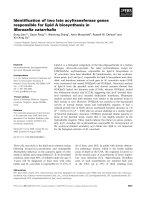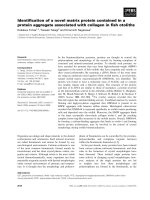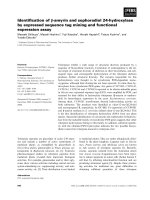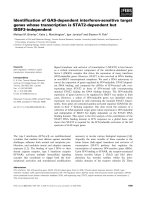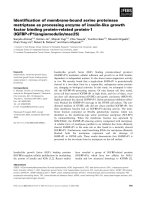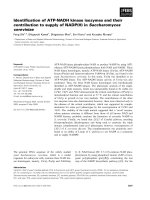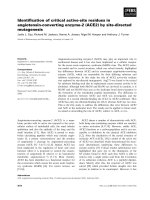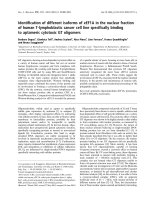Báo cáo khoa học: Identification of a preferred substrate peptide for transglutaminase 3 and detection of in situ activity in skin and hair follicles pdf
Bạn đang xem bản rút gọn của tài liệu. Xem và tải ngay bản đầy đủ của tài liệu tại đây (541.55 KB, 11 trang )
Identification of a preferred substrate peptide for
transglutaminase 3 and detection of in situ activity in skin
and hair follicles
Asaka Yamane
1,
*, Mina Fukui
1,
*, Yoshiaki Sugimura
1
, Miho Itoh
1
, Mileidys Perez Alea
2
,
Vincent Thomas
2
, Said El Alaoui
2
, Masashi Akiyama
3
and Kiyotaka Hitomi
1
1 Department of Applied Molecular Biosciences, Graduate School of Bioagricultural Sciences, Nagoya University, Japan
2 CovalAb, Villeurbanne, France
3 Department of Dermatology, Hokkaido University Graduate School of Medicine, Sapporo, Japan
Introduction
Transglutaminases (TGases: EC 2.3.2.13) are a family
of enzymes that catalyze the calcium-dependent forma-
tion of isopeptide cross-links between glutamine and
lysine residues in various proteins [1,2]. Furthermore,
these enzymatic reactions include the attachment of
primary amines to peptide-bound glutamine residues,
and the conversion of glutamine to glutamic acid. To
date, eight TGase isozymes (Factor XIII, TGases 1–7),
Keywords
epidermis; hair follicle; phage-display; skin;
transglutaminase
Correspondence
K. Hitomi, Department of Applied Molecular
Biosciences, Graduate School of
Bioagricultural Sciences, Nagoya University,
Nagoya 464-8601, Japan
Fax: +81 52 789 5542
Tel: +81 52 789 5541
E-mail:
*These authors contributed equally to this
work
(Received 13 May 2010, revised 4 July
2010, accepted 6 July 2010)
doi:10.1111/j.1742-4658.2010.07765.x
Transglutaminases (TGases) are a family of enzymes that catalyze cross-
linking reactions between proteins. During epidermal differentiation, these
enzymatic reactions are essential for formation of the cornified envelope,
which consists of cross-linked structural proteins. Two main transglutamin-
ases isoforms, epidermal-type (TGase 3) and keratinocyte-type (TGase 1),
are cooperatively involved in this process of differentiating keratinocytes.
Information regarding their substrate preference is of great importance to
determine the functional role of these isozymes and clarify their possible
co-operative action. Thus far, we have identified highly reactive peptide
sequences specifically recognized by TGases isozymes such as TGase 1,
TGase 2 (tissue-type isozyme) and the blood coagulation isozyme, Fac-
tor XIII. In this study, several substrate peptide sequences for human
TGase 3 were screened from a phage-displayed peptide library. The pre-
ferred substrate sequences for TGase 3 were selected and evaluated as
fusion proteins with mutated glutathione S-transferase. From these studies,
a highly reactive and isozyme-specific sequence (E51) was identified.
Furthermore, this sequence was found to be a prominent substrate in the
peptide form and was suitable for detection of in situ TGase 3 activity in
the mouse epidermis. TGase 3 enzymatic activity was detected in the layers
of differentiating keratinocytes and hair follicles with patterns distinct
from those of TGase 1. Our findings provide new information on the
specific distribution of TGase 3 and constitute a useful tool to clarify its
functional role in the epidermis.
Abbreviations
bio-Cd, 5-(biotinamido)pentylamine; CE, cornified envelope; Dansyl-Cd, monodansylpentylamine; FITC, fluorescein isothiocyanate;
GST, glutathione S-transferase; SPR, small proline-rich protein; TBS, Tris ⁄ buffered saline; TGase, transglutaminase.
3564 FEBS Journal 277 (2010) 3564–3574 ª 2010 The Authors Journal compilation ª 2010 FEBS
comprising a protein family with unique substrate
specificities and different tissue distributions, have been
identified in mammals. Factor XIII and TGase 2 are
involved in the stabilization of fibrin clots and various
roles including apoptosis, extracellular matrix forma-
tion and wound healing, respectively [3–6]. TGase 1
and TGase 3 have been reported to contribute to the
formation of the epidermis by cross-linking structural
proteins in keratinocytes [7–9]. TGase 4 is expressed in
the prostate and is reported to be involved in plug for-
mation in rodents [10]. The biochemical characteriza-
tion and physiological roles of TGase 5 (expressed in
keratinocytes), TGase 6 and TGase 7 remain unknown
[11,12].
In a TGase-catalyzed reaction, a glutamine residue
in the substrate binds to the cysteine residue at the
active site of the enzyme, resulting in the formation of
an intermediate. This is a rate-limiting step because
not all glutamine residues participate in the reaction.
By contrast, the reaction with the second substrate, a
lysine residue or a primary amine, is less selective.
Moreover, distinct isozymes recognize distinct gluta-
mine residues in the same protein. Therefore, primary
and secondary structures surrounding the reactive
glutamine residues are critical in the formation of an
intermediate enzyme–substrate complex. Each isozyme
in the TGase family, mainly characterized as TGase 1,
TGase 2 and Factor XIII, demonstrates different sub-
strate recognition patterns because the glutamine resi-
dues in the substrate involved in binding to the
enzyme are isozyme specific [13,14].
We have established a screening system that employs
a phage-displayed random peptide library to character-
ize the preferred substrate sequences for TGase [15–18].
In a series of studies, 12-mer sequences acting as iso-
zyme-specific substrates for Factor XIII, TGase 1 and
TGase 2 were obtained. From these studies, we selected
the most reactive and isozyme-specific substrate
sequences that were functional not only as phage-
display proteins, but also as peptide forms. Further-
more, in our recent reports, the most reactive peptide
sequence (K5), selected as a TGase 1-preferred sub-
strate, was successfully used as a probe to detect in situ
enzymatic activity in both human and mouse skin
[16,19]. These studies have provided new insight into
the substrate specificity of Tgases and have expanded
the range of application of the enzyme reaction [20].
TGase 3, initially designated as an epidermal-type
enzyme, is responsible for formation of the epidermis
[21,22]. In the current model of TGase function, during
keratinocyte differentiation, TGase 1 and TGase 3
are believed to act cooperatively in the cross-linking
of proteins, including involucrin, loricrin and small
proline-rich proteins (SPRs). Such concerted reactions
result in formation of the cornified envelope (CE),
a specialized component consisting of covalent cross-
links of proteins beneath the plasma membrane of
terminally differentiated keratinocytes [23,24]. Further-
more, TGase 3 in hair follicles is involved in cross-
linking structural proteins such as trichohyalin and
keratin intermediate to hardening the inner root sheath.
In this case, TGase 1 co-operates with TGase 3 through
a cross-linking reaction to produce stable hair fibers.
During differentiation in these processes, a zymogen
form of TGase 3 (77 kDa) is activated by limited prote-
olysis with cathepsins S and ⁄ or L [25,26]. Although sev-
eral studies have focused on the localization, structural
analysis and activation mechanism of TGase 3 zymo-
gen, not much information is available about the sub-
strate specificity and physiological function of the active
form [27–31]. In particularly, the precise substrate speci-
ficity and local activation areas of TGase 1 and
TGase 3 in the epidermis have not been fully identified.
In this study, we applied a screening system to
obtain the preferred substrate peptides for human
TGase 3. The selected phages displayed a unique ten-
dency toward the primary sequences, and the most
reactive and isozyme-specific sequence among the pep-
tide sequences was determined. Furthermore, this
sequence proved to be a prominent substrate in the
peptide form. Specific localization of activated
TGase 3, which was found to display a pattern distinct
from that of TGase 1, was observed by the detection
of in situ activities using this peptide.
Results
Screening of candidate substrate sequences from
a random peptide library
Phage clones in a random peptide library were
incubated with biotinylated cadaverine (bio-Cd), a
glutamine-acceptor substrate, in the presence of the
activated form of human TGase 3 (Fig. S1). By the
enzymatic reaction, phage particles displaying the reac-
tive glutamine residues preferably incorporate bio-Cd.
Avidin affinity purification resulted in the selection of
phage particles that covalently bound bio-Cd. The
phage particles were amplified and subjected to four
additional enzymatic reactions and panning. Sequence
analysis of the finally selected individual phage clones
(125 clones) revealed that 93.6% (117 ⁄ 125) of the
clones displayed peptide sequences containing gluta-
mine residue. In this process, false-positive clones con-
taining no glutamine residue might be co-purified if
the sequence has an affinity to avidin.
A. Yamane et al. Preferred substrate peptide for TGase 3
FEBS Journal 277 (2010) 3564–3574 ª 2010 The Authors Journal compilation ª 2010 FEBS 3565
When the peptide sequences were aligned and ana-
lyzed with respect to the potential reactive glutamine
residue, the following significant tendencies among the
sequences were observed: (a) a hydrophobic amino
acid was commonly observed at position +3 (relative
to the glutamine residue); (b) lysine or arginine mainly
was found at position +2; and (c) in most sequences,
an aromatic amino acid and a serine ⁄ threonine residue
were frequently located at positions )1 and +1,
respectively. Figure 1 shows the representative
sequences that were further analyzed for their reactiv-
ity as substrates.
Evaluation of selected sequences as recombinant
peptide-fused glutathione S-transferase (GST)
proteins
To evaluate the ability of the screened peptide
sequences as a glutamine-donor substrate, we mea-
sured the amount of enzymatic incorporation of the
primary amine, monodansylcadaverine (Dansyl-Cd), in
recombinant peptide-GST(QN) fusion proteins, in
which all the glutamine residues in glutathione S-trans-
ferase (GST) had been substituted by asparagines. The
peptide sequences shown in Fig. 1 were expressed as
fusion proteins and the time-course products formed
by the catalytic reaction of TGase 3 were subjected to
SDS ⁄ PAGE and visualized by UV illumination. Using
this procedure, 16 of the 29 sequences, including a no-
glutamine-containing sequence as a negative control,
were selected based on their reactivities (Fig. 1,
marked with asterisk). The enzymatic products, with
dimethylcasein as a positive control, were aligned as
shown in Fig. 2A. Among the sequences that exhibited
incorporation of Dansyl-Cd, seven peptides (under-
lined sequences: E8, E12, E18, E115, E46, E10 and
E51) were selected based on their reactivities and fur-
ther analyzed for their isozyme specificity with respect
to human TGase 1, guinea-pig liver TGase (as
TGase 2) and human Factor XIII (Fig. 2B). All the
sequences showed negligible reactivity in the reaction
catalyzed by Factor XIII. However, five sequences (E8,
E12, E115, E46 and E10) exhibited cross-reactivities to
guinea-pig liver TGase and one (E18) to TGase 1.
Among the seven peptide–GST(QN) fusion proteins
evaluated in this study, only the E51 sequence showed
less cross-reactivity to other isozymes although display-
ing prominent reactivity to TGase 3. Thus, this peptide
sequence was selected for further analysis.
Substitution-mutant analysis for each amino acid
to alanine in the E51 peptide sequence
To examine the contribution of each amino acid resi-
due of the E51 sequence (PPPYSFYQSRWV) in the
catalytic reaction of TGase 3, alanine substitution
mutants for every residue of the 12-amino acid peptide
were generated as GST(QN)-fusion proteins. Wild-type
and a mutant in which the reactive glutamine was
substituted by asparagine were also subjected to the
analysis (Fig. 3). According to the catalytic reaction of
TGase 3, substitutions at positions )2 (F), +1 (S), +2
(R) and +3 (W) significantly affected the reactivity
(colored as darker gray: < 50% intensity of that in
wild-type). In addition, substitution at positions )5 (P)
and +4 (V) resulted in a moderate decrease in reactiv-
ity. These results suggest that these amino acids con-
tribute to the interaction of E51 with the enzyme to
form an intermediate between the glutamine residue in
the substrate and the cysteine residue in the active site
pocket of TGase 3.
Assessment of reactivity and specificity of E51
sequence in the peptide form (pepE51)
To assess the reactivity and isozyme-specificity of E51
(PPPYSFY
QSRWV) in peptide form, biotinylated pep-
tides for E51 (pepE51) or E51 in which the reactive
*
E12
YDYWPMQTRTRT
*
E50
WGPQQT
R
IPSYR
E524
IK FPEQ TR I WHA
*
E8
WTQ TRF TTPF PE
E47
EWFGQVRI
H
PM
S
*
E51
PP PY S F YQ SRW V
*
E10
WN F A E Q T R L F K A
*
E21
LMPQ TRL EPHML
FSPGA
L
PLRMQF
E33
E9
YQ QRL YMP TWP P
*
E1
YQ T KW PM E F SSR
*
E18
FQ LKV P A A VWS D
E6
YQ LKY T HWA H T P
E53
FQ YK L N F GQY V Y
*
E125
A
E
RP N I M
V
*
*
I
VK
L
*
E42
WT TQMKM PHHA F
E110
FYQRPL PAHLLG
*
E4
FNYQAYL D I PRY
E55
FPYQTLFNPTPM
E68
WP YQ IMM GHARA
*
E46
NYWSWPGQ ISYH
E17
NPY
YQ I F NWAW
E510
WE TQQSW L F SN L
E45
TYQHIWHP
S
LA
L
E5
YQ I T L P Y R Y EMP
*
E111
WQ S P I T F P L T L A
*
E115
WQ T Q V V L H E E P L
E70
YSQSTH ALFSAR
*
E2
KMPEDTRLHNFA
Q
Q
Fig. 1. Selected sequences and alignment of candidate substrate
peptide. Selected 12-mer peptide sequences were aligned based
on the putative reactive glutamine residue. The glutamine residue,
hydrophobic amino acids at position +3 (relative to the glutamine),
and the arginine and the lysine residues at position +2 are shaded.
Phage ID (E) is shown at the left of the amino acid sequence. The
asterisk indicates the sequences of which reactivities were subse-
quently shown in Fig. 2.
Preferred substrate peptide for TGase 3 A. Yamane et al.
3566 FEBS Journal 277 (2010) 3564–3574 ª 2010 The Authors Journal compilation ª 2010 FEBS
glutamine residue was substituted by asparagine
(pepE51QN: PPPYSFY
NSRWV) were synthesized for
examination. Both peptides were subjected to a
TGase 3-catalyzed cross-reaction with a primary amine
(spermine), covalently immobilized to a microtiter well,
in the presence of activated TGase 3 [32,33]. As shown
in Fig. 4A, a time-course-dependent incorporation of
pepE51 was observed, whereas pepE51QN did not
show any reactivity. Moreover, in contrast to
pepE51QN, increasing concentrations of pepE51 enzy-
matically cross-linked with the coated spermine
(Fig. 4B). In addition, b-casein as a glutamine-acceptor
substrate appeared to accept pepE51 (data not shown).
These results demonstrate that pepE51 acts as a good
substrate, similarly to the fusion protein.
To further investigate whether the isozyme specificity
was preserved, the reactivity of pepE51 at various con-
centrations was evaluated in the presence of other
TGase isozymes including TGase 1, TGase 2 and acti-
vated Factor XIII (Fig. 5). A negative control was par-
alleled using pepE51QN. In each case, pepE51 showed
less cross-reactivity with the isozymes at the examined
peptide concentrations, except for a weak reaction with
guinea-pig liver TGase at a higher concentration
(> 2.5 lm). This result suggests that pepE51 at a con-
centration below 1 lm can be used as a specific peptide
in this reaction.
Detection of in situ activities of TGase in the skin
and hair follicles
Previously, we found that a fluorescent-labeled sub-
strate peptide for TGase 1 [fluorescein isothiocyanate
(FITC)–pepK5] could be used as a prominent probe
for detecting in situ activity of TGase 1 in both mouse
and human skin [16,19]. Therefore, using a similar pro-
cedure, fluorescent-labeled E51 peptide (FITC–pepE51)
was prepared and evaluated for detecting in situ activ-
ity of TGase 3 in a frozen mouse skin section.
As shown in Fig. 6, in the presence of CaCl
2
, specific
incorporation of FITC–pepE51 (1 lm) in endogenous
glutamine-acceptor substrate proteins was observed in
the epidermis. Reaction using FITC–pepE51QN, or in
the presence of EDTA resulted in no signal, indicating
that the signal was specific for TGase 3 activity.
Moreover, we inspected enlarged images of the skin
section (Fig. 7A). In the epidermis, positive signals
were observed around the granular and spinous layers
and not in the outermost cornified layers, judging from
the merged image with differential interference images.
When compared with signals obtained using FITC–
pepK5, the slightly weak and more limited regions in
the layers were stained with FITC–pepE51. This result
suggested that TGase 3 was active in more differentiat-
ing keratinocytes.
0251020
(min)
DMC
TGase 1 TGase 2 Factor XIII
0 2 5 10 20 0 2 5 10 20
0251020(min)
DMC
E6
0251020
(min)
E8
E12
E18
E8
E12
E50
E42
E46
E125
E4
E10
E115
E46
E10
E111
E18
E115
E21
E51
E1
E2
E51
AB
Fig. 2. Evaluation of the reactivities of the selected peptides as GST(QN) fusion proteins. (A) Incorporation of Dansyl-Cd into the purified
recombinant GST(QN) fusion proteins with peptide that were selected by phage display screening, in the presence of activated TGase 3
(1 ngÆlL
)1
). At the times indicated, the reaction products were separated on 12.5% SDS ⁄ PAGE and illuminated by UV light. Unreacted
fusion proteins were stained with Coomassie Brilliant Blue and are shown on the right. The underlined sequences are subjected to further
analysis for cross-reactivities. (B) Cross-reactivities to three isozymes regarding the selected seven GST(QN)-fusion proteins. Each protein
reacted at the indicated times in the presence of TGase 1 (1.5 ngÆlL
)1
), guinea-pig liver TGase (TGase 2) (2.5 ngÆlL
)1
) and activated Fac-
tor XIII (5 ngÆlL
)1
) were analyzed by SDS ⁄ PAGE and UV illumination. All the enzymatic activities were normalized based on the incorporation
of Dansyl-Cd into dimethylcasein.
A. Yamane et al. Preferred substrate peptide for TGase 3
FEBS Journal 277 (2010) 3564–3574 ª 2010 The Authors Journal compilation ª 2010 FEBS 3567
Next, the staining pattern of the hair follicles was
investigated (Fig. 7B,C). The distribution of signals
was different when FITC–pepK5 and FITC–pepE51
were used. According to the FITC–pepE51 pattern,
the activated TGase 3 was mainly located in the
medulla and the hair cortex. However, according to
the FITC–pepK5 pattern, TGase 1 activity was
observed around the outer root sheath and cuticle and
in differentiated inner root sheath cells. Thus, TGase 1
and TGase 3 appeared active in distinct regions of the
hair follicle cells.
Discussion
During differentiation of keratinocytes and hair forma-
tion, isopeptide cross-linking of several structural pro-
teins is essential for the formation of the insoluble
proteinaceous layers, the CE, which contribute to
effective physical and water barrier formation. Upon
CE formation in keratinocytes and hair follicle cells,
TGase 3 cross-links various substrate proteins such as
SPRs, involucrin, loricrin and trichohyalin [7–9,23,24].
In addition to the endogenous substrates, some pro-
teins of human papillomavirus have been described as
possible substrates for inducing an abnormality in CE
formation [34]. Previous studies have determined the
cross-linking sites of these proteins and suggest that
they display a pattern distinct from that obtained with
TGase 1 [35–38]. In these reports, for example, the
sequences QLQQQQVK (SPR1, Q19), SQQVTQT
(loricrin, Q219), HQTQQK (loricrin, Q305),
SSQQQKQ (SPR1, Q5 and Q7) and SQQVTQT (lori-
crin, Q215 and Q216) were determined as cross-linking
sites by TGase 1 and TGase 3, respectively. However,
differences in reaction specificities between these two
isozymes are not fully understood. A better under-
standing of the preferred substrate sequences for
TGase 3 will provide useful information for clarifying
the process of cross-linking.
To date, with respect to the major members of the
TGases family such as TGase 1, TGase 2 and Fac-
tor XIII, we have investigated the preferred substrate
0.8
1.0
pepE51
0
0.2
0.6
0.4
Absorbance
pepE51QN
0.5
0
25
010 1550
20
Time (min)
pepE51
Absorbance
0.1
0.3
0.2
0.4
pepE51QN
pepE51
0
52310 4
Peptide (µM)
A
B
Fig. 4. Analysis of the reactivity of E51 sequence in the peptide
form. (A) The time-dependent incorporation of 5 l
M biotinylated
peptide E51 (pepE51) into spermine, that covalently attached to
microtiter well, was examined in the presence of activated TGase 3
(0.5 ngÆlL
)1
). The mutant peptide in which the glutamine was chan-
ged to asparagine (pepE51QN) was paralleled. (B) On the various
concentrations of biotin-labeled peptides, incorporation into coated-
spermine was measured in the same reaction condition at incuba-
tion time of 10 min. The closed and open symbols represent the
reactions for pepE51 and pepE51QN, respectively. Data represent
the means ± SD of triplicate samples.
1.2
0.4
0.6
0.8
1
0
0.2
Relative value
–
–
–
–
–
–
–
Fig. 3. Assessment of contribution of each amino acid residue of
E51 sequence to substrate recognition. Alanine substitution
mutants in the E51 sequence were produced as GST(QN) fusion
proteins, and then incubated with Dansyl-Cd for 10 min in the pres-
ence of activated TGase 3 (1 ngÆlL
)1
). The reaction products were
subjected to SDS ⁄ PAGE, followed by UV illumination. The fluores-
cence intensity was analyzed by Fuji multigauge quantification sys-
tem. The relative values are normalized to the intensity for the
reaction of wild-type. Data represent the means ± SD of duplicate
samples. Numbers ()7P to +4V) with amino acid residue indicate
the position of substitution; WT, peptide in which there were no
amino acid substitution; QN, peptide in which the glutamine resi-
due was changed to asparagine. The mutations that resulted in
decrease in the reactivity at < 50% of that in wild type are shaded
in darker gray.
Preferred substrate peptide for TGase 3 A. Yamane et al.
3568 FEBS Journal 277 (2010) 3564–3574 ª 2010 The Authors Journal compilation ª 2010 FEBS
sequences around the reactive glutamine residue from
a phage-displayed peptide library [15,16]. In these pre-
vious studies, the identified preferred substrate
sequences displayed a unique tendency for each
isozyme, Q-x-R ⁄ K-W-x-x-x-W-P to TGase 1, Q-x-P-W-
D-P to TGase 2 and Q-x-x-W-x-W-P to Factor XIII (x
and W are any amino acid and hydrophobic amino
acid residues, respectively). We applied a similar
approach to obtain information regarding the pre-
ferred substrate sequence for TGase 3, with particular
interest in a highly reactive substrate peptide suitable
for the detection of in situ enzymatic activity.
In this study, the preferred sequences for TGase 3
selected from the phage-displayed peptide library
exhibited different tendencies compared with other
TGase isozymes. With respect to the peptides that
exhibited higher reactivities to TGase 3, the Q-S ⁄ T-
K ⁄ R-W consensus primary sequence was identified.
The sequence motif, Q-x-K ⁄ R is frequently observed in
several skin substrate sequences and also contained in
the preferred substrate sequence that we previously
identified for TGase 1 [16]. In the case of TGase 3, ser-
ine or threonine residues are frequently observed at
position +1. Interestingly, the amino acid located at
this position is not important for the reaction in other
Tgases, including TGase 1. In addition, at the N-termi-
nal side of the glutamine residue including position -1,
bulk amino acid residues such as tyrosine, proline and
phenylalanine are located in the case of the selected
sequence for TGase 3. This tendency is specific to
TGase 3 and is not observed in TGase 1 and other
isozymes.
Among the selected sequences, E51 (PPPYS-
FYQSRWV) was the most prominent substrate with
respect to TGase 3 reactivity and isozyme specificity.
This sequence also satisfied the amino acid residue ten-
dency, described previously. Alanine substitutions at
positions )2, +1, +2 and +3 of the selected E51
sequence significantly affected reactivity. The results
suggest that these residues are essential for interaction
with activated TGase 3.
Recently, we established a rapid and sensitive assay
system using biotinylated preferred substrate peptide
and spermine-coated microtiter plates. The reactivity
and specificity of the E51 sequence was maintained in
a biotinylated peptide form (pepE51) when the primary
amine was used as a glutamine-acceptor substrate. At
low concentrations, pepE51 exhibits high reactivity
with TG3 and very low reactivity with other isozymes
under these enzymatic activities (Fig. 5). In the case
of guinea-pig liver TGase, used as TGase 2, a weak
cross-reactivity was observed possibly resulting from
the co-purification of activated TGase 3. Thus, the
synthesized peptide for the E51 sequence represents a
valuable tool for studying TGase 3 substrate recogni-
tion and enzymatic activity.
Therefore, we examined the ability of the E51
sequence to detect endogenous TGase activity in the
pepK5
Guinea pig liver TGase (TGase 2)TGase 1
pepT26
0.4
0.5
0.4
0.5
0.6
pepE51QN
pepE51
0.1
0.2
0.3
0.1
0.3
0.2
pepE51QN
pepE51
Absorbance
Absorbance
Absorbance
0
5432
1
0
5432
10
pepE51QN
Peptide (µM)
Peptide (µ
M)
Peptide (µ
M)
Peptide (µ
M)
pepF11
Factor XIII
0.6
0.5
TGase 2
pepT260.6
0.5
Absorbance
pepE51
0.2
0.4
0.3
pepE51
0.2
0.4
0.3
pepE51
pepE51QN
0
543210
0.1
0
543210
pepE51QN0.1
A
B
C
D
Fig. 5. Cross-reactivities of pepE51 with
other major isozymes. On the various con-
centrations of pepE51 and pepE51QN as
well as three specific biotin-labeled peptides
(pepK5; TGase 1, pepT26; TGase 2, pepF11;
Factor XIII), incorporation into coated-sper-
mine was measured in the presence of
each isozyme, TGase 1 (0.075 ngÆlL
)1
) (A),
guinea-pig liver TGase (0.12 ngÆlL
)1
) (B),
TGase 2 (0.06 ngÆlL
)1
) (C), and activated
Factor XIII (0.24 ngÆlL
)1
) (D) for 15 min. All
the enzymatic activities were normalized
based on the incorporation of Dansyl-Cd into
dimethylcasein. The closed circles represent
the reactions for pepK5, pepT26 and pepF11
in each isozyme reaction. The closed and
open rectangles indicate the reaction for
pepE51 and pepE51QN, respectively.
Data represent the means ± SD of triplicate
samples.
A. Yamane et al. Preferred substrate peptide for TGase 3
FEBS Journal 277 (2010) 3564–3574 ª 2010 The Authors Journal compilation ª 2010 FEBS 3569
skin, as previously established for TGase 1-preferred
substrate peptide, K5 [16]. Using a similar approach,
calcium-dependent incorporation of FITC–pepE51
through its glutamine residue into lysine residues of
endogenous substrate proteins was observed (Figs 6
and 7). TGase 3 has been observed in both differenti-
ating keratinocytes and hair follicles of the epidermis
by immunochemical analyses [38–40]. However, in this
study, we present the first direct evidence for the detec-
tion of activated TGase 3 in the epidermis. Therefore,
this finding provides more precise information on the
physiological significance of TGase 3 because this
enzyme is synthesized as an inactive zymogen form.
In the epidermis, endogenous TGase 3 activity was
observed mostly in the granular and spinous layers.
However, the activity was detected within a more lim-
ited region when compared with the staining results
obtained with FITC–pepK5, a preferred substrate for
TGase 1. In addition, in hair follicle cells, the staining
pattern of TGase 3 was distinct from that of TGase 1.
In situ activity of the enzyme was observed mainly
around the inner root sheath, which is consistent with
results obtained previously using immunostaining
analyses [39,40]. By contrast, TGase 3 activity was
found around the medulla and hair cortex. These
results for TGase 3 in the epidermis and hair follicles
are convincing; however, in cells with higher TGase 1
activity, there might be the possibility of a slight cross-
reaction with TGase 1.
In a recent study that used immunochemical analysis
and in situ detection of the activity by FITC-labeled
cadaverine, Thibaut et al. [40] reported that TGase 3
was mainly present in hair fibers. This is mostly consis-
tent with our results. However, in their study, the
FITC-E51 FITC-K5DIC Merge
A
B
C
Fig. 7. In situ TGase activities detected
with FITC-labeled peptides in the mouse
skin epidermis and hair follicles. In situ
activity of TGase 3 was detected under the
observation at enlarged scale in the same
reaction condition as described in the
legend to Fig. 6. From left, FITC–pepE51
(1 l
M), differential interference images and
their merged images are aligned. FITC–
pepK5 (1 l
M) was paralleled in each experi-
ment (right). (A) Skin epidermis, (B) transver-
sal and (C) longitudinal sections of hair
follicles. Bar represents 50 lm.
FITC-E51/CaCl
2
FITC-E51QN/CaCl
2
FITC-E51/EDTA
Fig. 6. Detection of in situ TGase 3 activities in the mouse skin
section. Hematoxylin and eosin staining is shown at the left. FITC–
pepE51 (1 l
M) was reacted with frozen mouse skin section in the
presence of CaCl
2
. As a negative control, incubation with FITC–
pepE51QN and co-presence of EDTA in the reaction of pepE51
were carried out under the same reaction condition. Bar represents
50 lm.
Preferred substrate peptide for TGase 3 A. Yamane et al.
3570 FEBS Journal 277 (2010) 3564–3574 ª 2010 The Authors Journal compilation ª 2010 FEBS
detection procedure for TGase in situ activity was not
specific for TGase 3 in principle, because cadaverine is
an amine substrate known to react with any active
TGase.
Although aberrant TGase 1 activity has been
reported in several skin diseases, as a consequence of
genetic mutation [41,42], nothing has been reported
regarding a TGase 3 defect in specific pathologies.
Investigation of in situ activity of TGase 3 is a valu-
able method for elucidating the precise role of this iso-
zyme in a variety of tissues and cells. Recently,
detection of altered enzymatic activities in patients
with TGase 1 mutation was successfully achieved using
FITC–pepK5 [19]. Because this method is applicable
for monitoring aberrant expression of TGase 3 activ-
ity, it will assist in the investigation unknown diseases
which may be caused by TGase 3 mutations.
In conclusion, we have identified several preferred
substrate sequences for TGase 3. The most reactive
peptide sequence, E51, permitted the detection of
in vitro and in situ activities of the active enzyme. In
addition to pepK5, a specific preferred substrate
peptide for TGase 1, pepE51 could become a useful
tool to further characterize TGase activity and identify
endogenous substrates in the skin and hair follicles.
Experimental procedures
Transglutaminases
For screening, human recombinant TGase 3 obtained by
expression and purification from baculovirus-infected insect
cells was used, as described previously [27]. For evaluation
of the obtained sequences, recombinant human TGases 1, -2
and -3 and purified guinea-pig liver TGase were purchased
from Zedira (Darmstadt, Germany) and Sigma (St. Louis,
MO, USA). For the activation of TGase 3, the zymogen was
proteolyzed by treatment with dispase (Roche, Mannheim,
Germany). Human Factor XIII (Fibrogammin
R
P; ZLB
Behring, Marburg, Mannheim, Germany) was activated
(Factor XIIIa) by treatment with bovine thrombin (Sigma).
Screening of preferred sequences from a
phage-displayed peptide library
Screening was carried out as described previously, using an
M13 PhD-12 phage-display system (New England Biolabs
Inc., Ipswich, MA, USA) [15]. Briefly, 1.5 · 10
11
(first-
round panning) phage clones were incubated at 37 °C with
dispase-activated TGase 3 (1 ngÆ lL
)1
)in10mm Tris ⁄ HCl
(pH 8.0), 150 mm NaCl (TBS buffer) containing 1 mm dith-
iothreitol, 5 mm CaCl
2
and 5 mm bio-Cd [EZ-linkÔ 5-(bi-
otinamido)pentylamine; Pierce Biotechnology, Rockford,
IL, USA]. The catalytic reaction was stopped by the addi-
tion of EDTA. The phage particles were precipitated in the
presence of poly-(ethylene glycol) and NaCl with salmon
sperm DNA as a carrier. Next, phage clones that covalently
incorporated bio-Cd were selected by affinity chromatogra-
phy using mono-avidin gel (SoftLinkÔ Soft Release Avidin
Resin; Promega Corp., Madison, WI, USA). After washing
with TBS containing 0.1 or 0.5% Tween 20 and 2 mm
EDTA and then with TBS, the bound phage particles were
eluted by competition using 5 mm biotin in TBS buffer.
The entire eluate was used to infect ER2738 host bacteria
to amplify the phages. The phage particles were concen-
trated by precipitation with poly-(ethylene glygol)–NaCl
and then used for subsequent rounds. After panning five
times in all, DNA sequences of the displayed peptides of
the selected phage clones were determined.
Construction of the expression vector for GST
fusion proteins
The vector plasmid pET24d–GST(QN) was used to express
modified GST, in which all the glutamine residues were
substituted by asparagine residues, and fused with a peptide
at the N-terminus and hexahistidine at the C-terminus [15].
The DNA of each phage was isolated and the sequences of
the displayed 12-mer peptides were amplified by PCR. The
amplified PCR products were digested and inserted into
pET24d–GST(QN). To generate peptide mutants in which
each amino acid was substituted to alanine, PCR-based
mutagenesis was carried out.
Escherichia coli BL21(DE3)LysS or BL21(DE3)LysE was
transformed with the plasmids and expression was induced
by the addition of isopropyl b-d-thiogalactoside. Recombi-
nant proteins were purified using TALON Metal Affinity
Resin according to the manufacture’s instructions (BD Biosci-
ence, San Jose, CA, USA). The concentration of the purified
protein was determined by quantification of the intensity for
the separated bands in SDS ⁄ PAGE analysis using imaging
software ( multigauge software; Fujifilm, Tokyo, Japan).
Evaluation of the preferred sequences using the
recombinant proteins
The reactivities of recombinant GST(QN)-fusion proteins
were evaluated by the incorporation of Dansyl-Cd (Sigma),
a fluorescence-labeled pentylamine. Recombinant protein
(200 ngÆlL
)1
) and 0.5 mm Dansyl-Cd were incubated in
TBS containing 5 mm CaCl
2
and 1 mm dithiothreitol in the
presence of activated TGase 3 (1 ngÆlL
)1
). Dimethylcasein
(Sigma) was used as a positive control at a final concentra-
tion of 200 ngÆlL
)1
. The reaction mixture was incubated at
37 °C and then separated by 12.5% SDS ⁄ PAGE. A fluoro-
graph of the gel was obtained by UV irradiation (254 nm)
to visualize the amount of incorporated Dansyl-Cd. To
quantify the results, the fluorescence intensity of each
A. Yamane et al. Preferred substrate peptide for TGase 3
FEBS Journal 277 (2010) 3564–3574 ª 2010 The Authors Journal compilation ª 2010 FEBS 3571
product was analyzed using imaging software (multigauge
software).
Evaluation of synthetic peptides as a substrate
The 12-amino acid peptide corresponding to the E51
sequence (PPPYSFYQSRWV) was synthesized and biotiny-
lated at the N-terminus (pepE51). A mutant peptide in which
glutamine was substituted to asparagine was also synthesized
(PPPYSFY
NSRWV) and biotinylated as pepE51QN.
TGase 1-, TGase 2- and Factor XIII-preferred substrate
biotinylated peptides, being pepK5 (YEQHKLPSSWPF),
pepT26 (HQSYVDPWMLDH) and pepF11 (DQMMLPW-
PAVAL), respectively, were used for comparison.
To evaluate the activity and specificity of the peptides, a
microtiter plate assay was performed as described previ-
ously [32,33]. Spermine, as a primary amine, was immobi-
lized covalently onto microplates. The enzyme reaction
mixture, in a total volume of 100 lL, contained biotinylated
peptide in the presence of the enzymes in an appropriate
buffer (final concentration: 20 mm Tris ⁄ HCl, pH 8.3,
140 mm NaCl, 2.5 mm dithiothreitol, 15 mm CaCl
2
). The
microtiter plates were incubated at 37 °C for the indicated
time intervals and the reaction was stopped by the addition
of EDTA (50 mm at final concentration). The wells were
then washed with a Tris-based buffer (10 mm Tris ⁄ HCl, pH
8.0, 150 mm NaCl, 0.1% Tween-20). The incorporated
biotinylated peptides were detected using streptavidin-per-
oxidase (Rockland Immunochemicals Inc., Gilbertsville,
PA, USA) and the peroxidase substrate 3,3¢,5,5¢-tetrameth-
ylbenzidine (Sigma).
Detection of in situ TGase activities in the mouse
skin sections
Animal care and experiments were conducted according
to the Regulations for Animal Experiments in Nagoya
University.
Immediately after the mice had been killed by diethyle-
ther anesthetization, the skin was dissected and embedded
in medium (Sakura Finetek, Tokyo, Japan) as a standard
method. Frozen sections were dissected into 4–8 l m slices
and kept frozen until use. Fluorescence-labeled peptides
(FITC–pepE51, FITC–pepE51QN and FITC–pepK5) were
synthesized.
For the reaction, sections were dried and then blocked
by incubation in NaCl ⁄ P
i
containing 1% BSA (Sigma) for
30 min at room temperature. Sections were incubated for
90 min with a solution containing 100 mm Tris ⁄ HCl (pH
8.0), 5 mm CaCl
2
or 5 mm EDTA and 1 mm dithiothreitol,
in the presence of FITC-labeled peptide at 37 °C. After
washing with NaCl ⁄ P
i
three times, anti-fading solution was
mounted onto the section with a cover-glass. Differential
interference images and fluorescence were analyzed with a
confocal laser-scanning microscope, LSM5 PASCAL (Zeiss,
Go
¨
ttingen, Germany). For hematoxylin and eosin staining,
the tissue section was fixed, then stained using standard
methods and analyzed with a microscope, BZ-8100 (Key-
ence, Osaka, Japan).
Acknowledgements
We greatly appreciate Dr Masatoshi Maki and Dr
Hideki Shibata in our laboratory for providing valuable
suggestions. This work was supported by a Grant-in-
Aid for Scientific Research on Innovative Areas (No.
20200072) from the Ministry of Education, Sports,
Science and Technology (MEXT, Japan) (to KH) and
the Marie Curie Action RTN program ‘Transgluta-
minase: role in pathogenesis, diagnosis and therapy’
(TRACKS; contract No. MRTN-CT-2008-36032).
References
1 Griffin M, Casadio R & Bergamini CM (2002) Trans-
glutaminases: nature’s biological glues. Biochem J 368,
377–396.
2 Lorand L & Graham RM (2003) Transglutaminases:
crosslinking enzymes with pleiotropic functions. Nat
Rev Mol Cell Biol 4, 140–156.
3 Ichinose A (2001) Physiopathology and regulation of
Factor XIII. Thromb Haemost 86, 57–65.
4Fe
´
su
¨
s L & Piacentini M (2002) Transglutaminase 2: an
enigmatic enzyme with diverstic functions. Trends
Biochem Sci 27, 534–539.
5Fe
´
su
¨
s L & Szondy Z (2005) Transglutaminase 2 in the
balance of cell death and survival. FEBS Lett 579,
3297–3302.
6 Telci D & Griffin M (2006) Tissue transglutaminase
(TG2) – a wound response enzyme. Front Biosci 11,
867–882.
7 Eckert RL, Sturniolo MT, Broome AM, Ruse M &
Rorke EA (2005) Transglutaminase function in epider-
mis. J Invest Dermatol 124 , 481–492.
8 Hitomi K (2005) Transglutaminase in skin epidermis.
Eur J Dermatol 15, 313–319.
9 Zeeuwen PL (2004) Epidermal differentiation: the role
of proteases and their inhibitors. Eur J Cell Biol 83,
761–773.
10 Esposito C, Pucci P, Amoresano A, Marino G,
Cozzolino A & Porta R (1996) Transglutaminase from
rat coagulating gland secretion. Post-translational
modification and activation by phosphatidic acids.
J Biol Chem 271, 27416–27423.
11 Candi E, Oddi S, Paradisi A, Terrinoni A, Ranalli M,
Teofoli P, Citro G, Scarpato S, Puddu P & Melino G
(2002) Expression of transglutaminase 5 in normal and
pathologic human epidermis. J Invest Dermatol 119,
670–677.
Preferred substrate peptide for TGase 3 A. Yamane et al.
3572 FEBS Journal 277 (2010) 3564–3574 ª 2010 The Authors Journal compilation ª 2010 FEBS
12 Pietroni V, Di Giorgi S, Paradisi A, Ahvazi B, Candi E
& Melino G (2008) Inactive and highly active, proteo-
lytically processed transglutaminase-5 in epithelial cells.
J Invest Dermatol 128, 2760–2766.
13 Esposito C & Caputo I (2005) Mammalian transgluta-
minases: identification of substrates as a key to physio-
logical function and physiological relevance. FEBS J
272, 615–631.
14 Facchiano A & Facchiano F (2009) Transglutaminases
and their substrates in biology and human diseases:
50 years of growing. Amino Acids 36, 599–614.
15 Sugimura Y, Hosono M, Wada F, Yoshimura T, Maki
M & Hitomi K (2006) Screening for the preferred sub-
strate sequence of transglutaminase using a phage-dis-
played peptide library: identification of peptide
substrates for TGase 2 and Factor XIIIa. J Biol Chem
281, 17699–17706.
16 Sugimura Y, Hosono M, Kitamura M, Tsuda T,
Yamanishi K, Maki M & Hitomi K (2008) Identification
of preferred substrate sequences for transglutaminase
1-development of a novel peptide that can efficiently
detect cross-linking enzyme activity in the skin. FEBS J
275, 5667–5677.
17 Sugimura Y, Yokoyma K, Nio N, Maki M & Hitomi
K (2008) Identification of preferred substrate sequences
of microbial transglutaminase from Streptomyces
mobaraensis using a phage-displayed peptide library.
Arch Biochem Biophys 477, 379–383.
18 Hitomi K, Kitamura M & Sugimura Y (2009) Preferred
substrate sequences for transglutaminase 2: screening
using a phage-displayed peptide library. Amino Acids
36, 619–624.
19 Akiyama M, Sakai K, Yanagi T, Fukushima S, Ihn H,
Hitomi K & Shimizu H (2010) Transglutaminase 1
preferred substrate peptide K5 is an efficient tool in
diagnosis of lamellar ichthyosis. Am J Pathol 176,
1592–1599.
20 Sugimura Y, Ueda H, Maki M & Hitomi K (2007)
Novel site-specific immobilization of a functional
protein using a preferred substrate sequence for
transglutaminase 2. J Biotechnol 131, 121–127.
21 Kim HC, Lewis MS, Gorman JJ, Park SC, Girard JE,
Folk JE & Chung SI (1990) Protransglutaminase E
from guinea pig skin. Isolation and partial characteriza-
tion. J Biol Chem 265, 21971–21978.
22 Kim I-G, Gorman JJ, Park S-C, Chung S-I & Steinert
PM (1993) The deduced sequence of the novel protrans-
glutaminase E (TGase3) of human and mouse skin.
J Biol Chem 268, 12682–12690.
23 Kalinin AE, Kajava AV & Steinert PM (2002) Epithe-
lial barrier function: assembly and structural features of
the cornified envelop. Bioessays 24, 789–800.
24 Candi E, Schmidt R & Melino G (2005) The cornified
envelope: a model of cell death in the skin. Nat Rev
Mol Cell Biol 6, 328–340.
25 Cheng T, Hitomi K, van Vlijmen-Willems IM, Jongh
G, Yamamoto K, Nishi K, Watts C, Reinheckel T,
Schalkwijk J & Zeeuwen PM (2006) Cystatin M ⁄ Eisa
high affinity inhibitor of cathepsin V and the short
chain form of cathepsin L by a reactive site that is
distinct from the legumain-binding site. A novel clue for
the role of cystatin M ⁄ E in epidermal cornification.
J Biol Chem 281, 15893–15899.
26 Zeeuwen PM, Cheng T & Schalkwijk J (2009) The
biology of cystatin M ⁄ E and its cognate target protease.
J Invest Dermatol 129, 1327–1338.
27 Hitomi K, Kanehiro S, Ikura K & Maki M (1999)
Characterization of recombinant mouse epidermal-type
transglutaminase (TGase 3): regulation of its activity by
proteolysis and guanine nucleotides. J Biochem (Tokyo)
125, 1048–1054.
28 Hitomi K, Horio Y, Ikura K, Yamanishi K & Maki M
(2001) Analysis of epidermal-type transglutaminase
expression in mouse tissues and cell lines. Int J Biochem
Cell Biol 33, 491–498.
29 Ahvazi B, Boeshans KM, Idler W, Baxa U & Steinert P
(2003) Roles of calcium ions in the activation and activ-
ity of the transglutaminase 3 enzyme. J Biol Chem
278,
23834–23841.
30 Hitomi K, Presland RB, Nakayama T, Fleckman P,
Dale BA & Maki M (2003) Analysis of epidermal-
type transglutaminase (transglutaminase 3) in
human stratified epithelia and cultured keratinocytes
using monoclonal antibodies. J Dermatol Sci 32,
95–103.
31 Ahvazi B, Boeshans KM & Rastinejad F (2004) The
emerging structural understanding of transglutamin-
ase 3. J Struct Biol 147, 200–207.
32 Alea MP, Kitamura M, Martin G, Thomas V, Hitomi
K & El Alaoui S (2009) Development of a highly sensi-
tive and specific colorimetric assay for the measurement
of TGase 2 cross-linking activity. Anal Biochem 389,
150–156.
33 Hitomi K, Kitamura M, Alea MP, Ceylan I, Thomas V
& El Alaoui S (2009) A specific colorimetric assay for
measuring of transglutaminase 1 and Factor XIII activi-
ties. Anal Biochem 394, 281–283.
34 Brown DR, Kitchin D, Qadadri B, Neptune N,
Batteiger T & Ermel A (2006) The human papillomavirus
type 11 E1^E4 protein is a transglutaminase 3 substrate
and induces abnormalities of the cornified cell envelope.
Virology 345, 290–298.
35 Tarcsa E, Candi E, Kartasova T, Idler WW, Marekov
LN & Steinert PM (1998) Structural and transglutamin-
ase substrate properties of the small proline-rich 2 fam-
ily of cornified cell envelope proteins. J Biol Chem 273,
23297–23303.
36 Candi E, Tarcsa E, Idler WW, Kartasova T, Marekov
LN & Steinert PM (1999) Transglutaminase cross-link-
ing properties of the small proline-rich 1 family of
A. Yamane et al. Preferred substrate peptide for TGase 3
FEBS Journal 277 (2010) 3564–3574 ª 2010 The Authors Journal compilation ª 2010 FEBS 3573
cornified cell envelope proteins. Integration with
loricrin. J Biol Chem 274, 7226–7237.
37 Candi E, Melino G, Mei G, Tarcsa E, Chung S-I,
Marekov LN & Steinert PM (1995) Biochemical, struc-
tural, and transglutaminase substrate properties of
human loricrin, the major epidermal cornified cell
envelope protein. J Biol Chem 270, 26382–26390.
38 Tarcsa E, Marekov LN, Andreoli J, Idler WW, Candi
E, Chung S-I & Steinert P (1997) The fate of trichohya-
lin: sequential post-translational modifications by
peptidyl-arginine deiminase and transglutaminase.
J Biol Chem 272, 27893–27901.
39 Akiyama M, Matsuo I & Shimizu H (2002) Formation
of cornified cell envelope in human hair follicle develop-
ment. Br J Dermatol 146, 968–976.
40 Thibaut S, Cavusoglu N, Becker E, Zerbib F, Bednarczk
A, Schaeffer C, Dorsselaer A & Bernard B (2009)
Transglutaminase-3 enzyme: a putative actor in human
hair shaft scaffolding? J Invest Dermatol 129, 449–459.
41 Huber M, Rettler I, Bernasconi K, Frenk E, Lavrijsen
SPM, Ponec M, Bon A, Lautenschlager S, Schorderet
DF & Hohl D (1995) Mutations of keratinocyte trans-
glutaminase in lamellar ichthyosis. Science 267, 525–528.
42 Akiyama M, Takizawa Y, Suzuki Y, Ishiko A, Matsuo
I & Shimizu H (2001) Compound heterozygous TGM1
mutations including a novel missense mutation L204Q
in a mild form of lamellar ichthyosis. J Invest Dermatol
116, 992–995.
Supporting information
The following supplementary material is available:
Fig. S1. Screening procedure for substrate sequences
preferred by TGase 3 using a phage-displayed random
peptide library.
This supplementary material can be found in the
online version of this article.
Please note: As a service to our authors and readers,
this journal provides supporting information supplied
by the authors. Such materials are peer-reviewed and
may be re-organized for online delivery, but are not
copy-edited or typeset. Technical support issues arising
from supporting information (other than missing files)
should be addressed to the authors.
Preferred substrate peptide for TGase 3 A. Yamane et al.
3574 FEBS Journal 277 (2010) 3564–3574 ª 2010 The Authors Journal compilation ª 2010 FEBS

